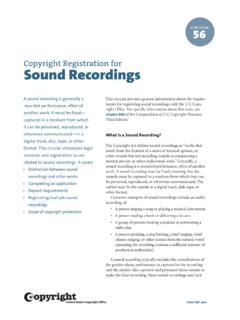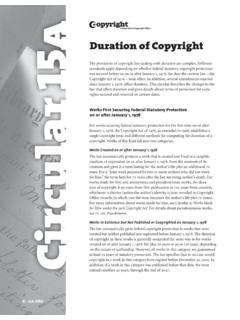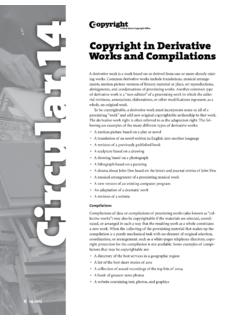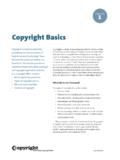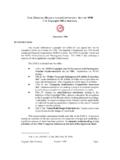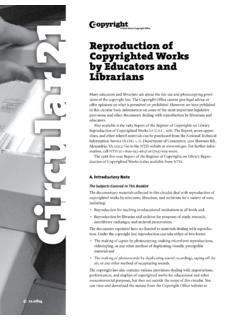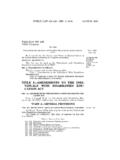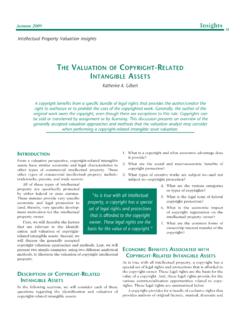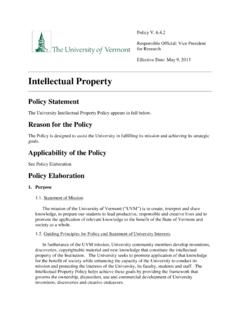Transcription of How to Investigate the Copyright Status of a Work …
1 WCircular 222 to Investigate the Copyright Status of a WorkIn GeneralMethods of Approaching a Copyright InvestigationThere are several ways to Investigate whether a work is under Copyright protec-tion and, if so, the facts of the Copyright . These are the main ones: 1 Examine a copy of the work for such elements as a Copyright notice, place and date of publication, author and publisher. If the work is a sound recording, examine the disc, tape, cartridge, or cassette in which the recorded sound is fixed, or the album cover, sleeve, or container in which the recording is sold. 2 Search the Copyright Office catalogs and other records. 3 Have the Copyright Office conduct a search for Few Words of Caution About Copyright InvestigationsCopyright investigations often involve more than one of these methods. Even if you follow all three approaches, the results may not be conclusive. Moreover, as explained in this circular, the changes brought about under the Copyright Act of 1976, the Berne Convention Implementation Act of 1988, the Copyright Renewal Act of 1992, and the Sonny Bono Copyright Term Extension Act of 1998 must be considered when investigating the Copyright Status of a circular offers some practical guidance on what to look for if you are making a Copyright investigation.
2 It is important to realize, however, that this circular contains only general information and that there are a number of exceptions to the principles outlined here. In many cases, it is important to con-sult with a Copyright attorney before reaching any conclusions regarding the Copyright Status of a to Search Copyright Office Catalogs and RecordsCatalog of Copyright EntriesThe Copyright Office published the Catalog of Copyright Entries (CCE) in printed format from 1891 through 1978. From 1979 through 1982, the CCE was issued in microfiche format. The CCE is divided into parts according to the classes of works registered. Each CCE segment covers all registrations made during a particular period of time. Renewal registrations made from 1979 through 1982 are found in Section 8 of the catalog. Renewals prior to that time How to Investigate Copyright Status 2are generally listed at the end of the volume containing the class of work to which they number of libraries throughout the U.
3 S. maintain copies of the CCE, and this may provide a good starting point if you wish to make a search yourself. There are some cases, however, in which a search of the CCE alone will not be sufficient to provide the needed information. For example: Because the CCE does not include entries for assignments or other recorded documents, it cannot be used for searches involving the ownership of rights. The CCE entry contains the essential facts concerning a registration, but it is not a verbatim transcript of the registration record. It does not contain the address of the Copyright with registrations made since 1982 when the CCE was discontinued, the only method of searching CCE volumes outside the Library of Congress is by using the Internet to access the online catalog. The online catalog contains entries from 1978 to the present. Information on accessing the cata-log via the Internet is provided below. The Copyright Office has been digitizing the 660 volumes of the CCE and many are now available at Individual Searches of Copyright RecordsThe Copyright Office is located in the Library of Congress, James Madison Memorial Building, 101 Independence Avenue SE, Washington, DC Copyright Office records are open to public inspec-tion and searching from 8:30 am to 5:00 pm, eastern time, Monday through Friday, except federal holidays.
4 The various records freely available to the public include an extensive card catalog, an automated catalog containing records from 1978 forward, record books, and microfilm records of assign-ments and related documents. Other records, including correspondence files and deposit copies, are not open to the public for searching. However, they may be inspected upon request and payment of a search fee.**note: Copyright Office fees are subject to change. For current fees, please check the Copyright Office website at , write the Copyright Office, or call (202) 707 3000 or 1 877 476 you wish to do your own searching in the Copyright Office files open to the public, you will be given assistance in locating the records you need and in learning procedures for searching. If the Copyright Office staff member actually makes the search for you, a search fee must be charged. The search will not be done while you addition, Copyright Office records in machine-read-able form cataloged from January 1, 1978, to the present, including registration and renewal information and recorded documents, are available for searching from the Copyright Office website at Copyright Office does not offer search assistance to users on the by the Copyright OfficeIn GeneralUpon request and at the statutory rate for each hour or fraction of an hour used, the Copyright Office staff will search the records of registrations and other recorded docu-ments concerning ownership of copyrights and will provide a written report.
5 If you request a cost estimate, the Copyright Office will provide one. Estimates for searches are based on the information you furnish and are provided for a set fee that is applied toward the cost of the search and report. Fees for estimates are nonrefundable and may be applied to a search for up to one year from the date of the estimate. Requests must include an address and telephone number where you may be reached during business hours and an email address if of a search report is available for an addi-tional fee. Certified searches are frequently requested to meet the evidentiary requirements of payment is by personal check or credit card. Contact the Copyright Office for information regarding pay-ment with money orders or by overseas banking information, correspondence, or payment, contact: Copyright Office GC/I&R/RRCAttn: RCCP. O . Box 70400 Washington, DC 20024phone: (202) 707-6787 (m f, 8:30 5:00 eastern time)fax: (202) 252-3519email: the Fee Does Not CoverThe search fee does not include the cost of additional certifi-cates, photocopies of deposits, or copies of other Office records.
6 For information concerning these services, see Circular 6, Obtaining Access to and Copies of Copyright Office Records and to Investigate Copyright Status 3 Information NeededThe more detailed information you furnish with your request, the less expensive the search will be. Please provide as much of the following information as possible: the title of the work, with any possible variants the names of the authors, including possible pseudonyms the name of the probable Copyright owner, which may be the publisher or producer the approximate year when the work was published or registered the type of work involved (book, play, musical composi-tion, sound recording, photograph, etc.) for a work originally published as a part of a periodical or collection, the title of that publication and any other information, such as the volume or issue number, to help identify it the registration number or any other Copyright data Motion pictures are often based on other works, such as books or serialized contributions to periodicals or other composite works.
7 If you want a search for an underlying work or for music from a motion picture, you must specifically request such a search. You must also identify the underlying works and music and furnish the specific titles, authors, and approximate dates of these Involving Assignments and Other Documents Affecting Copyright OwnershipFor the standard hourly search fee, the Copyright Office staff will search its indexes covering the records of assignments and other recorded documents concerning ownership of copyrights. The reports of searches in these cases will state the facts shown in the Office s indexes of the recorded docu-ments but will offer no interpretation of the content of the documents or their legal on SearchesIn determining whether or not to have a search made, you should keep the following points in mind:No Special Lists The Copyright Office does not maintain any lists of works by subject or any lists of works that are in the public Not Listed Separately in Copyright Office Records Individual works such as stories, poems, articles, or musical compositions that were published as contribu-tions to a copyrighted periodical or collection are usually not listed separately by title in our Comparisons The Copyright Office does not search or compare copies of works to determine questions of possible infringement or to determine how much two or more ver-sions of a work have in and Names Not Copyrightable Copyright does not protect names and titles, and our records list many different works identified by the same or similar titles.
8 Some brand names, trade names, slogans, and phrases may be entitled to protection under the general rules of law relating to unfair competition. They may also be entitled to registration under the provisions of the trademark laws. Questions about the trademark laws should be addressed to: Commissioner for Patents, PO Box 1450, Alexandria, VA 22313-1450. Possible pro-tection of names and titles under common law principles of unfair competition is a question of state Legal Advice The Copyright Office cannot express any opinion as to the legal significance or effect of the facts included in a search Words of CautionSearches Not Always ConclusiveSearches of the Copyright Office catalogs and records are useful in helping to determine the Copyright Status of a work, but they cannot be regarded as conclusive in all cases. The complete absence of any information about a work in the Office records does not mean that the work is unprotected. The following are examples of cases in which informa-tion about a particular work may be incomplete or lacking entirely in the Copyright Office: Before 1978, unpublished works were entitled to protec-tion under common law without the need of registration.
9 Works published with notice prior to 1978 may be registered at any time within the first 28-year term. Works copyrighted between January 1, 1964, and Decem-ber 31, 1977, are affected by the Copyright Renewal Act of 1992, which automatically extends the Copyright term and makes renewal registrations optional. For works under Copyright protection on or after January 1, 1978, registration may be made at any time during the term of protection. Although registration is not required as a condition of Copyright protection, there are certain How to Investigate Copyright Status 4definite advantages to registration. For further informa-tion, see Circular 1, Copyright Basics. Since searches are ordinarily limited to registrations that have already been cataloged, a search report may not cover recent registrations for which catalog records are not yet available. The information in the search request may not have been complete or specific enough to identify the work. The work may have been registered under a different title or as part of a larger in Foreign CountriesEven if you conclude that a work is in the public domain in the United States, this does not necessarily mean that you are free to use it in other countries.
10 Every nation has its own laws governing the length and scope of Copyright protection, and these are applicable to uses of the work within that nation s borders. Thus, the expiration or loss of Copyright protection in the United States may still leave the work fully protected against unauthorized use in other countries. For further information, see Circular 6; Circular 15, Renewal of Copy-right; and Circular 15a, Duration of of the Copyright Act on Copyright InvestigationsOn October 19, 1976, the President signed into law a com-plete revision of the Copyright law of the United States (title 17 of the United States Code). Most provisions of this statute came into force on January 1, 1978, superseding the Copyright Act of 1909. These provisions made significant changes in the Copyright law. Further important changes resulted from the Berne Convention Implementation Act of 1988, which took effect March 1, 1989; the Copyright Renewal Act of 1992 ( 102-307) enacted June 26, 1992, which amended the renewal provisions of the Copyright law; and the Sonny Bono Copyright Term Extension Act of 1998 ( 105-298) enacted October 27, 1998, which extended the term of copyrights for an additional 20 years.

